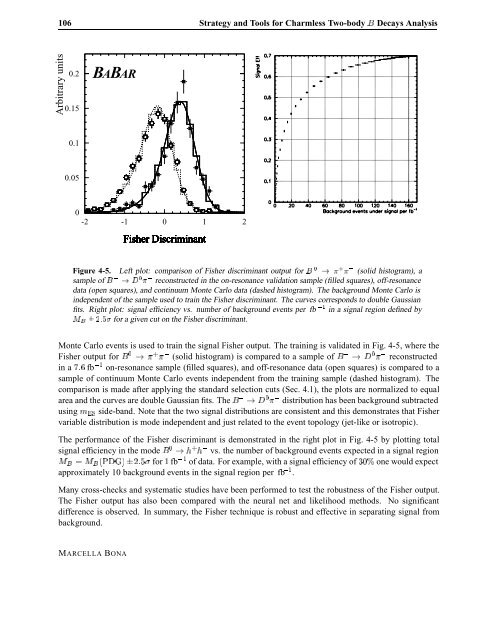Violation in Mixing
Violation in Mixing
Violation in Mixing
Create successful ePaper yourself
Turn your PDF publications into a flip-book with our unique Google optimized e-Paper software.
106 Strategy and Tools for Charmless Two-body � Decays Analysis<br />
Arbitrary units<br />
0.2<br />
0.15<br />
0.1<br />
0.05<br />
BABAR<br />
0<br />
-2 -1 0 1 2<br />
Fisher Discrim<strong>in</strong>ant<br />
Figure 4-5. Left plot: comparison of Fisher discrim<strong>in</strong>ant output for � � � � (solid histogram), a<br />
sample of � � � � reconstructed <strong>in</strong> the on-resonance validation sample (filled squares), off-resonance<br />
data (open squares), and cont<strong>in</strong>uum Monte Carlo data (dashed histogram). The background Monte Carlo is<br />
<strong>in</strong>dependent of the sample used to tra<strong>in</strong> the Fisher discrim<strong>in</strong>ant. The curves corresponds to double Gaussian<br />
fits. Right plot: signal efficiency vs. number of background events per fb<br />
Å� ¦ ��� for a given cut on the Fisher discrim<strong>in</strong>ant.<br />
<strong>in</strong> a signal region def<strong>in</strong>ed by<br />
Monte Carlo events is used to tra<strong>in</strong> the signal Fisher output. The tra<strong>in</strong><strong>in</strong>g is validated <strong>in</strong> Fig. 4-5, where the<br />
Fisher output for � � � � (solid histogram) is compared to a sample of � � � � reconstructed<br />
<strong>in</strong> a ��� fb on-resonance sample (filled squares), and off-resonance data (open squares) is compared to a<br />
sample of cont<strong>in</strong>uum Monte Carlo events <strong>in</strong>dependent from the tra<strong>in</strong><strong>in</strong>g sample (dashed histogram). The<br />
comparison is made after apply<strong>in</strong>g the standard selection cuts (Sec. 4.1), the plots are normalized to equal<br />
area and the curves are double Gaussian fits. The � � � � distribution has been background subtracted<br />
us<strong>in</strong>g Ñ�Ë side-band. Note that the two signal distributions are consistent and this demonstrates that Fisher<br />
variable distribution is mode <strong>in</strong>dependent and just related to the event topology (jet-like or isotropic).<br />
The performance of the Fisher discrim<strong>in</strong>ant is demonstrated <strong>in</strong> the right plot <strong>in</strong> Fig. 4-5 by plott<strong>in</strong>g total<br />
signal efficiency <strong>in</strong> the mode � � � � vs. the number of background events expected <strong>in</strong> a signal region<br />
Å� � Å� È�� ¦ ��� for fb of data. For example, with a signal efficiency of one would expect<br />
approximately 10 background events <strong>in</strong> the signal region per fb .<br />
Many cross-checks and systematic studies have been performed to test the robustness of the Fisher output.<br />
The Fisher output has also been compared with the neural net and likelihood methods. No significant<br />
difference is observed. In summary, the Fisher technique is robust and effective <strong>in</strong> separat<strong>in</strong>g signal from<br />
background.<br />
MARCELLA BONA















